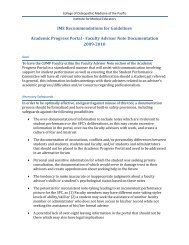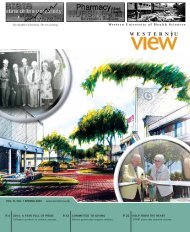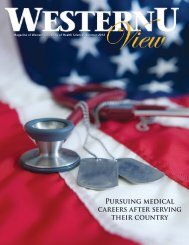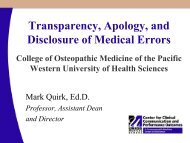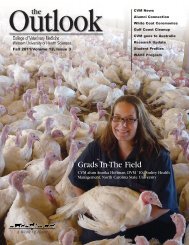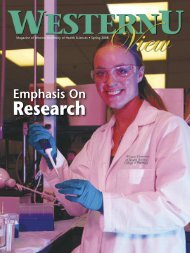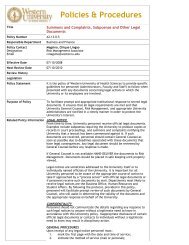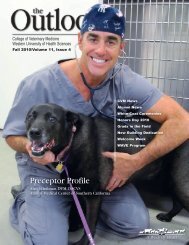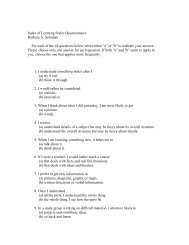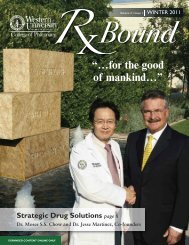Western University of Health Sciences
Western University of Health Sciences
Western University of Health Sciences
- No tags were found...
You also want an ePaper? Increase the reach of your titles
YUMPU automatically turns print PDFs into web optimized ePapers that Google loves.
FEATURES<br />
"Beyond question, I am proudest <strong>of</strong><br />
the level <strong>of</strong> quality attached to<br />
each <strong>of</strong> our programs.”<br />
— Warren Lawless<br />
BOARD CHAIRMAN’S DEDICATION STRONG AFTER 20 YEARS<br />
Warren Lawless has said that he was motivated to join the board <strong>of</strong> the College <strong>of</strong><br />
Osteopathic Medicine <strong>of</strong> the Pacific in 1978 because he wanted to see an osteopathic<br />
college formed to serve the western states. He first met Dr. Pumerantz at a joint<br />
convention <strong>of</strong> the Oregon and Washington Osteopathic Associations, and as they talked,<br />
Dr. Pumerantz brought up the subject <strong>of</strong> starting an osteopathic school in California.<br />
For the first time, Mr. Lawless said, he was confident that such a goal was attainable.<br />
Mr. Lawless, who has served as the board’s chairman since 1983, has seen many <strong>of</strong> the<br />
university’s trials and triumphs. In honoring Mr. Lawless on his 80th birthday, Dr.<br />
Pumerantz wrote, “Thanks to your continued advocacy and your constant nurturing <strong>of</strong><br />
the osteopathic philosophy, the quality <strong>of</strong> health care has been<br />
elevated to a new level throughout the western United States.”<br />
<strong>Western</strong>U View recently spoke with Mr. Lawless, now serving<br />
his 21st year as board chairman.<br />
Your background is originally in printing. How did you<br />
get involved in the world <strong>of</strong> osteopathic medicine and<br />
<strong>Western</strong>U<br />
Printing— in the era <strong>of</strong> the Linotype machine and moveable<br />
type set out <strong>of</strong> a California typecase—was my vocation starting<br />
out <strong>of</strong> high school. After an interruption for naval service in World War II, I returned to<br />
work at a weekly newspaper and commercial printing plant. A job managing the<br />
advertising department came up and I took it. In 1967, I, along with fellow workers, had<br />
an opportunity to buy a small printing, advertising and association management business.<br />
One <strong>of</strong> the associations we inherited was the Washington Osteopathic Medical<br />
Association. Later, I would become its executive director, a position I held for 21 years.<br />
As the pr<strong>of</strong>ession grew and issues <strong>of</strong> licensure, education, malpractice and reimbursement<br />
became more complex, the job became a full-time occupation. Both Washington<br />
and California experienced efforts to merge osteopathic and allopathic medicine.<br />
Through the years, the pr<strong>of</strong>ession in the West shared common problems. When the<br />
California Supreme Court reversed the law prohibiting licensing <strong>of</strong> DOs, Washington<br />
was interested in the formation <strong>of</strong> a new osteopathic college to train DOs for the western<br />
states. My association assigned me to represent it in the early stages <strong>of</strong> development<br />
and ultimately on the board <strong>of</strong> the College <strong>of</strong> Osteopathic Medicine <strong>of</strong> the Pacific.<br />
It must be a dream come true to have the<br />
Northwest Track. Any comments about this<br />
new venture<br />
From the outset, COMP was understood to<br />
be a regional institution serving 13 western<br />
states. Washington and Oregon, at that juncture,<br />
had fewer than 400 DOs in practice<br />
each; the other states, even fewer. Recruiting<br />
efforts in all the states was weak at best, and<br />
continued to be until the Northwest Track<br />
was conceived in early 2003. The program has<br />
some real potential. The 30 additional COMP<br />
seats allotted to students recruited from<br />
Washington, Oregon, Alaska, Idaho and<br />
Wyoming provide COMP with an opportunity<br />
to extend its influence as a unique pr<strong>of</strong>essional<br />
institution and strengthens the position <strong>of</strong><br />
osteopathic medicine in the West.<br />
What do you envision for the university in<br />
the next two decades<br />
After a 27-year period <strong>of</strong> meteoric<br />
growth in programs, public presence, buildings<br />
and practicing alumni, I see a period <strong>of</strong><br />
sharpened quality, self-assessment and<br />
measured outcomes leading to nationwide<br />
recognition which will reach a level <strong>of</strong><br />
reality far above our current expectations.<br />
4 Summer 2004 www.westernu.edu



